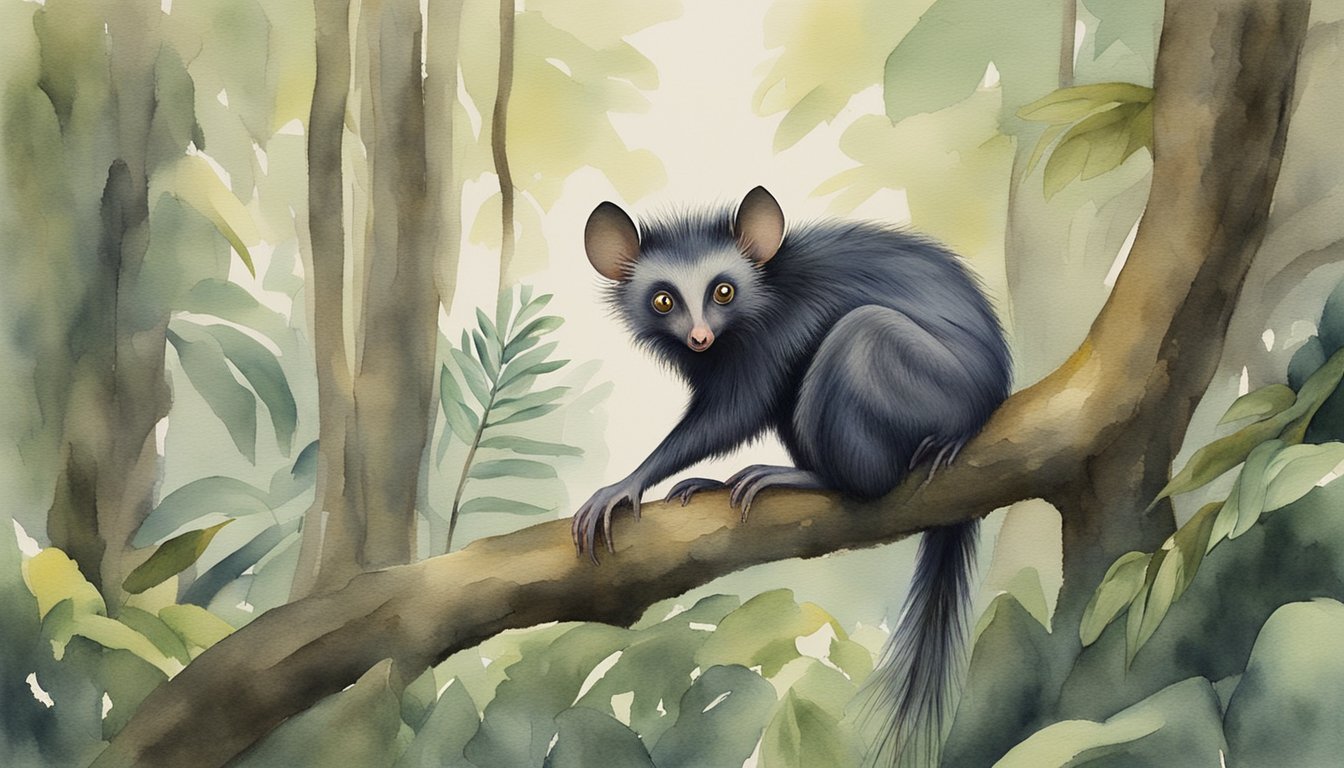Understanding the Aye-Aye
The aye-aye (Daubentonia madagascariensis) is a truly unique species, with its distinctive biology and nocturnal behaviors, and its peculiar distribution within the rainforests of Madagascar. This section delves into the biology and behavior that set the aye-aye apart, as well as the specific habitat this primate calls home.
Distinctive Biology and Behavior
The aye-aye is notable for its unusual anatomical features, which serve a critical role in its survival as a nocturnal primate. The species is recognized for its elongated middle finger, which is skeletal in appearance and highly adapted for a foraging behavior known as percussive foraging. This slender finger taps on trees to locate hollow areas where grubs may be hiding and then uses it to extract food, a method that could be likened to the foraging habits of a woodpecker. Along with this distinctive finger, the aye-aye’s incisors grow continuously, allowing it to gnaw through wood to reach insects. Its sensitive, large ears act almost like a form of echolocation to detect hollow spaces, a necessary adaptation to its nocturnal lifestyle.
Furthermore, the aye-aye is adapted to an arboreal existence with strong, opposable big toes that aid in gripping branches. Its bushy tail, which can measure up to three times the length of its body, provides balance and warmth. This primate’s eyes are also large, an adaptation for its nocturnal activities in the dense forests. For sustenance, aside from insects, the aye-aye’s diet includes fruits, seeds, nectar, and even fungi (mucophagy), which categorizes it as an omnivore.
Habitat and Distribution
The aye-aye is endemic to Madagascar, restricted in distribution due to its specific habitat requirements and anthropogenic pressures. Its presence spans across various types of forests in Madagascar, including coastal rainforests, deciduous forests, and secondary growth woodlands. The aye-aye thrives in regions that are rich in natural resources like fruit trees and trees infested with wood-boring insect larvae.
However, its habitat is increasingly at risk due to deforestation and habitat fragmentation. As a result, conservationists are focused on preserving the natural rainforests of Madagascar, which are not only vital to aye-ayes but to numerous other species, including a variety of lemurs, which share the region’s ecosystem. Within its habitat, the aye-aye is known to build spherical nests out of leaves and branches arranged high in the trees, which serve as a refuge from predators and as a resting place during the day.
How Does the Intelligence of Crows Compare to the Unique Adaptations of the Aye Aye?
Crows exhibit remarkable intelligence, showcasing problem-solving skills and social complexity. While the aye aye has unique adaptations for survival, such as its elongated middle finger for tapping trees, scientists often study crows to uncover avian cognitive abilities. This comparison highlights the diverse evolutionary paths of intelligence in the animal kingdom.
Conservation Status and Cultural Significance

The aye-aye, a distinctive nocturnal primate from Madagascar, faces conservation challenges due to habitat loss and cultural perceptions. While efforts to protect this species intensify, its cultural significance continues to affect its survival.
Challenges and Efforts to Protect the Aye-Aye
The aye-aye is currently listed as an Endangered species on the IUCN Red List of Threatened Species, with deforestation and hunting being the primary threats to its decreasing population. As a nocturnal and solitary creature with large home ranges, the loss of Madagascar’s deciduous forests due to logging and agriculture has significantly reduced their available habitat.
Conservation efforts include establishing protected areas within Madagascar and enforcing laws under CITES to prevent international trade. Additionally, breeding colonies such as those at the Duke Lemur Center, play a crucial role in understanding aye-aye behavior, breeding, and aiding in the species’ eventual recovery.
Myths and Human Interactions
The aye-aye has a unique place in Malagasy lore, often associated with bad luck or death—an aspect that has led to its persecution. This nocturnal primate, recognized for its percussive foraging technique—tapping on trees to find cavities with invertebrates—is sometimes killed on sight by locals due to the belief it predicts misfortune.
Despite these challenges, there are efforts to change perceptions through education about the aye-aye’s ecological role, such as their contribution to seed dispersal when feeding on fruits like coconuts, and their part in controlling pest populations by consuming insect larvae. The collaboration between conservation organizations and local communities is vital for the aye-aye’s conservation, as is highlighting the primate’s unique qualities and disproving harmful myths.

